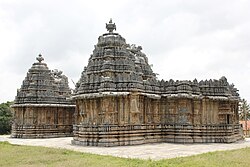Nageshvara-Chennakeshava Temple complex, Mosale
| Nageshvara-Chennakeshava Temple complex | |
|---|---|
| Hindu temple | |

Nageshvara (near) and Chennakeshava (far), 1200 C.E., in Mosale, Hassan district
|
|
| Coordinates: 12°54′5.63″N 76°08′32.28″E / 12.9015639°N 76.1423000°ECoordinates: 12°54′5.63″N 76°08′32.28″E / 12.9015639°N 76.1423000°E | |
| Country |
|
| State | Karnataka |
| District | Hassan District |
| Languages | |
| • Official | Kannada |
| Time zone | IST (UTC+5:30) |
| PIN | 577146 |
The Nageshvara-Chennakeshava temple complex (also spelt Nagesvara and Chennakesava) is an elegant example of Hoysala architecture of the early 12th century. It is located in the village of Mosale, about 10 km from Hassan city, in Hassan district of Karnataka state, India. The temple was built in 1200 A.D. during the reign of Hoysala King Veera Ballala II. According to art historian Gerard Foekema, the two temples that are built in the same complex, in an idyllic rural setting, form a "perfect twin". This temple complex is protected as a monument of national importance by the Archaeological Survey of India.
By plan, the temples are simple single-shrined structures with all the standard features of Hoysala architecture; a porch entrance into a square closed mantapa or navaranga (hall with no windows and a thick wall) leading to the sanctum, and a superstructure (shikhara) over the main shrine fitting the description of a ekakuta (single shrine with top). The sanctum (garbhagriha) is connected to the hall by a vestibule called sukhanasi. The closed hall, whose inner and outer walls are decorated, has four central lathe turned pillars that support a bay ceiling. The temples are constructed next to each other. The Nageshvara temple (lit, "Lord of snakes"), dedicated to the Hindu god Shiva (represented by his universal symbol, the linga) is in the south. The Chennakeshava temple (lit, "beautiful Vishnu"), dedicated to a standing cult image of the Hindu god Vishnu, is to the north. Since all features are replicated in the temples, Gerard Foekema considers the ensamble a dvikuta (two shrines with two towers).
The superstructure (tower or shikhara) over each shrine is three tiered (tritala arpita) and vesara in style. It is intact, finely sculptured and has a decorative low extension which is actually the tower over the vestibule (that connects the cella (sanctum) and the hall). The extension tower looks like the "nose" of the main superstructure and is also called sukhanasi. The sukanasi structure holds the beautiful Hoysala crest that depicts a royal warrior stabbing a lion. At the top of the superstructure of the shrine is a "helmet" like sculptured dome (amalaka) whose ground surface area can be 2x2 meters. It is the largest piece of sculpture in the temple. The amalaka supports a decorative water pot like structure called the kalasha which is the apex of the tower. All these features are intact in both temples.
...
Wikipedia
